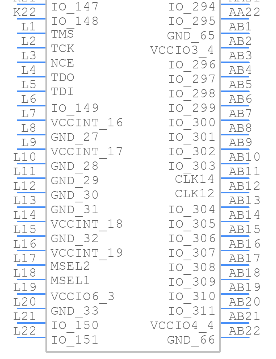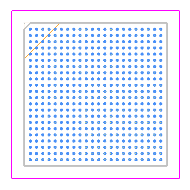EP3C55F484C8N FPGAs: Alternatives, Applications and Datasheet
2025-06-27 09:51:53 1452
EP3C55F484C8N Description
The EP3C55F484C8N is a member of the Cyclone® III family from Intel (formerly Altera). This low-cost, high-density FPGA offers 55,856 logic elements and is housed in a 484-pin FineLine BGA package. Built using a 65nm low-power process, it is optimized for cost-sensitive applications requiring rich logic density and moderate performance, all while maintaining low power consumption. The "C8N" suffix denotes a commercial-grade device with a speed grade of -8 and a lead-free (RoHS-compliant) package.
EP3C55F484C8N Features
Logic Elements: 55,856 LEs for implementing complex digital logic.
Embedded Memory: 2,396 Kbits of embedded memory blocks (M9K).
I/O Pins: 295 user I/O pins available.
PLL Support: 4 PLLs (Phase-Locked Loops) for flexible clock management.
Low Power Consumption: Designed with a 65 nm low-power process to minimize thermal design requirements.
Package: 484-pin FBGA (FineLine BGA), offering excellent electrical performance.
Speed Grade: -8 (medium-speed variant suitable for general applications).
EP3C55F484C8N Applications
Industrial Automation: Motor control, data acquisition systems.
Consumer Electronics: Image processing, LCD controllers, and interface bridging.
Communications: Protocol bridging, packet processing, and soft-core processors.
Medical Devices: Portable ultrasound, diagnostic imaging.
Automotive Systems: Non-critical subsystems like infotainment or ADAS prototyping.
EP3C55F484C8N CAD Model
Symbol

Footprint

3D Model


EP3C55F484C8N Alternatives
If you're looking for pin- or function-compatible alternatives, consider:
EP3C55F484I7N – Industrial-grade version with wider temperature support.
EP3C50F484C8N – Slightly fewer logic elements (50K LEs) for cost optimization.
EP4CE55F23C8N – Cyclone IV E family, better performance and more features in a similar logic range.
XC6SLX45T-3FGG484C (Xilinx Spartan-6) – Roughly equivalent in logic resources and pin count.
LFE3-70EA-6FN484C (Lattice ECP3) – Another cost-effective, low-power FPGA with similar logic density.
EP3C55F484C8N Manufacturer
Intel Corporation is a global technology company and one of the world’s leading manufacturers of semiconductor chips. Headquartered in Santa Clara, California, Intel was founded in 1968 by Robert Noyce and Gordon Moore, both pioneers in the development of integrated circuits.
Intel is widely recognized for its innovation in microprocessors — the central processing units (CPUs) that power the majority of personal computers and servers around the world. Over the decades, the company has played a critical role in shaping the computing landscape with its groundbreaking technologies, such as the x86 architecture, and continues to lead in high-performance computing, data centers, and AI.
In addition to CPUs, Intel also designs and manufactures a broad range of products, including FPGAs (Field-Programmable Gate Arrays), network interface controllers, embedded processors, graphics chips, memory, and Internet of Things (IoT) solutions. The acquisition of companies like Altera, Mobileye, and Tower Semiconductor further expanded Intel’s reach into areas like programmable logic, autonomous driving, and advanced chip fabrication.
Today, Intel is transforming itself into a full-stack technology provider, investing heavily in next-generation computing technologies such as artificial intelligence, 5G, autonomous systems, and foundry services, aiming to compete globally with companies like AMD, NVIDIA, TSMC, and Samsung.
EP3C55F484C8N FAQs
Question: Can the EP3C55F484C8N operate on a single 3.3V supply?
Answer: No. While the I/O banks can support 3.3V, the core requires 1.2V, and other voltages (like 2.5V/3.3V for I/O banks) must be supplied separately for proper operation.
Question: How do I configure the EP3C55F484C8N on power-up?
Answer: It supports multiple configuration schemes including Active Serial (AS), Passive Serial (PS), and JTAG. You can use an EPCQ device or a USB-Blaster for programming.
Question: What is the maximum clock frequency achievable with the -8 speed grade?
Answer:Typically around 250 MHz for internal logic, but this depends on design complexity and timing constraints.
Question: Can I implement DDR2/DDR3 memory interfaces using this device?
Answer:EP3C55F484C8N supports DDR and DDR2 memory interfaces, but not DDR3, which requires more advanced FPGA families with dedicated hard memory controllers.
Question: Is partial reconfiguration supported on the EP3C55F484C8N?
Answer: No. Cyclone III devices do not support partial reconfiguration. This feature is found in higher-end FPGA families like Stratix and some newer Cyclone V devices.




